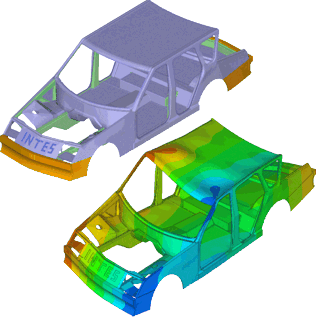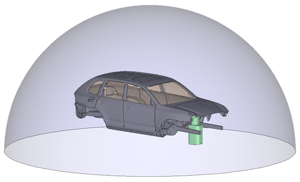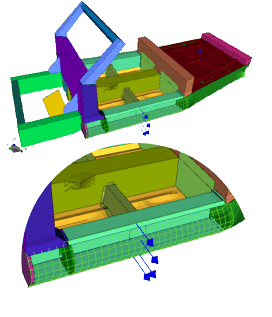For the subsequent response analysis, there are methods for the
frequency domain (i.e. frequency response analysis) and for the
time domain (i.e. time-history response analysis). These methods are
available as modal methods (based on previously determined
eigenfrequencies and mode shapes) and as direct methods (based on
full system matrices). For realistic models, the direct methods
are much more time consuming than modal methods. But the direct methods
are very accurate and can be used on a case-by-case basis to check
the accuracy of the modal models.
The dynamic loading (or excitation) can be specified by forces
(and moments) or prescribed displacements (or rotations) and a
frequency or time function which describes the course
of the excitation dependent on frequency or time.
- In frequency domain, the discretization of the excitation
frequency range is an important accuracy parameter for the
resulting response graphs. In particular,
the discretization of peaks is important and this is supported by
generation of clusters of excitation frequencies around
eigenfrequencies.
- If a time function is provided by measurements, beside a
time-history response an alternative approach is also available
to get a periodic response result. An internal FFT
(Fast Fourier transformation) is available to detect
the main excitation frequencies. For each
of these frequencies a frequency response can be performed
(with just one excitation frequency). The result of all these
harmonic response results can then be superimposed in the time
domain to get the periodic response (or
steady-state response).
- In time domain, the sampling rate should be related
to the time characteristics of the excitation function.
For response analysis, the specification of damping is very important.
There are a lot of ways to specify damping.
In particular, trimmed bodies require a detailed and accurate modeling
of all additional springs, masses, and dampers.
The results from a frequency response analysis are any complex primary
result (displacements, velocities, or accelarations) and
secondary result (e.g. stresses, strains, sound radiation power density)
for all nodes at any excitation frequency. Frequently, so-called
transfer functions are more important than the full fields of
result quantities. Transfer functions describe the relation between
the excitation points and any target point of interest (by a unit
excitation) for all excitation frequencies.
In order to reduce computational effort for response analysis the
user can specify the requested results in advance. In case of
requested transfer functions, the response analysis can be
restricted to a node set.



